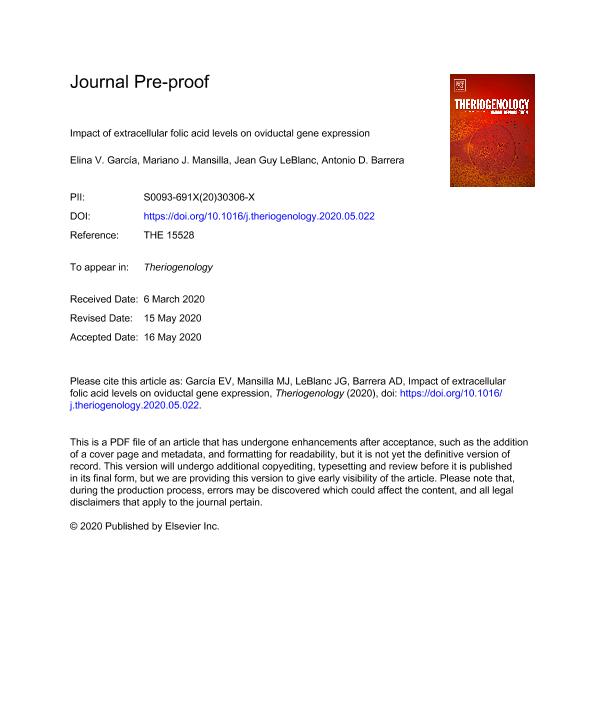Mostrar el registro sencillo del ítem
dc.contributor.author
Garcia, Elina Vanesa

dc.contributor.author
Mansilla, Mariano J.
dc.contributor.author
Leblanc, Jean Guy Joseph

dc.contributor.author
Barrera, Antonio Daniel

dc.date.available
2021-02-04T03:19:33Z
dc.date.issued
2020-09
dc.identifier.citation
Garcia, Elina Vanesa; Mansilla, Mariano J.; Leblanc, Jean Guy Joseph; Barrera, Antonio Daniel; Impact of extracellular folic acid levels on oviductal gene expression; Elsevier Science Inc; Theriogenology; 154; 9-2020; 161-170
dc.identifier.issn
0093-691X
dc.identifier.uri
http://hdl.handle.net/11336/124702
dc.description.abstract
Folate plays a specific role as methyl donor for nucleotide synthesis and genomic methylation patterns, which in turn are important epigenetic determinants in gene expression. Previous studies have revealed the presence of folate in bovine oviductal fluid as well as the existence of a fine-tuned regulation of the gene expression of folate receptors and transporters in bovine oviduct epithelial cells (BOECs). However, the functional implications of folate in the oviduct remain unknown. The present study aimed to assess the effect of folic acid (FA) on expression levels of selected genes that potentially respond to the folate status in in vitro BOECs. To obtain an insight into the optimization of a culture system for assays, gene expression of folate receptors and transporters was compared between BOECs grown in monolayers and in suspension. The results showed that BOECs from isthmus and ampulla in suspension culture better preserved the region-dependent gene expression profile than in monolayers. Subsequently, BOECs from both anatomical regions were separately cultured in suspension for 24 h assaying different FA concentrations: I) TCM-199 (control); II) TCM-199 + 1 μM FA (similar to the oviduct concentration); III) TCM-199 + 10 μM FA and IV) TCM-199 + 100 μM FA. Expression analysis of genes related to important cellular processes including folate transport, DNA methylation, cell-cell interaction, antioxidant activity and signaling pathways was performed in BOECs using RT-qPCR. Our data demonstrated that addition of 1 μM FA did not affect mRNA levels of most genes analyzed. In contrast, BOECs cultured with 10 μM FA exhibited increased mRNA expression levels of genes involved in folate intake, DNA methylation and antioxidant protection. It is worth noting that at 100 μM FA, transcriptional response in BOECs mainly resulted in decreased mRNA levels of the majority of the genes assayed. Interestingly, cytotoxicity analysis showed a similar LDH activity in the culture media of the experimental groups, indicating that cell integrity was not affected by the FA concentrations assayed. In conclusion, our findings suggest that folate can affect BOECs, promoting changes in gene activity in a framework of functional readjustments in response to environmental conditions.
dc.format
application/pdf
dc.language.iso
eng
dc.publisher
Elsevier Science Inc

dc.rights
info:eu-repo/semantics/openAccess
dc.rights.uri
https://creativecommons.org/licenses/by-nc-nd/2.5/ar/
dc.subject
FOLIC ACID
dc.subject
MICRONUTRIENT
dc.subject
OVIDUCT
dc.subject
OVIDUCTAL CELLS
dc.subject
TRANSCRIPTIONAL RESPONSE
dc.subject.classification
Biología Reproductiva

dc.subject.classification
Ciencias Biológicas

dc.subject.classification
CIENCIAS NATURALES Y EXACTAS

dc.subject.classification
Ciencias Veterinarias

dc.subject.classification
Ciencias Veterinarias

dc.subject.classification
CIENCIAS AGRÍCOLAS

dc.title
Impact of extracellular folic acid levels on oviductal gene expression
dc.type
info:eu-repo/semantics/article
dc.type
info:ar-repo/semantics/artículo
dc.type
info:eu-repo/semantics/publishedVersion
dc.date.updated
2020-12-04T18:35:14Z
dc.journal.volume
154
dc.journal.pagination
161-170
dc.journal.pais
Estados Unidos

dc.journal.ciudad
Massachusetts
dc.description.fil
Fil: Garcia, Elina Vanesa. Consejo Nacional de Investigaciones Científicas y Técnicas. Centro Científico Tecnológico Conicet Noa Sur. Instituto Superior de Investigaciones Biológicas. Grupo de Investigación y Desarrollo del Noroeste Argentino | Universidad Nacional de Tucumán. Instituto Superior de Investigaciones Biológicas. Grupo de Investigación y Desarrollo del Noroeste Argentino; Argentina. Universidad Nacional de Tucumán. Facultad de Bioquímica, Química y Farmacia. Instituto de Biología; Argentina
dc.description.fil
Fil: Mansilla, Mariano J.. Universidad Nacional de Tucumán. Facultad de Bioquímica, Química y Farmacia. Instituto de Biología; Argentina
dc.description.fil
Fil: Leblanc, Jean Guy Joseph. Consejo Nacional de Investigaciones Científicas y Técnicas. Centro Científico Tecnológico Conicet - Tucumán. Centro de Referencia para Lactobacilos; Argentina
dc.description.fil
Fil: Barrera, Antonio Daniel. Consejo Nacional de Investigaciones Científicas y Técnicas. Centro Científico Tecnológico Conicet Noa Sur. Instituto Superior de Investigaciones Biológicas. Grupo de Investigación y Desarrollo del Noroeste Argentino | Universidad Nacional de Tucumán. Instituto Superior de Investigaciones Biológicas. Grupo de Investigación y Desarrollo del Noroeste Argentino; Argentina. Universidad Nacional de Tucumán. Facultad de Bioquímica, Química y Farmacia. Instituto de Biología; Argentina
dc.journal.title
Theriogenology

dc.relation.alternativeid
info:eu-repo/semantics/altIdentifier/doi/https://doi.org/10.1016/j.theriogenology.2020.05.022
dc.relation.alternativeid
info:eu-repo/semantics/altIdentifier/url/https://www.sciencedirect.com/science/article/abs/pii/S0093691X2030306X
Archivos asociados
